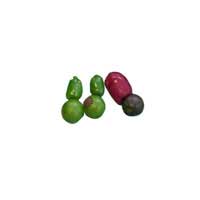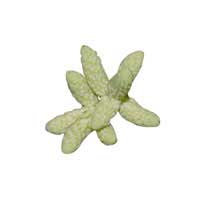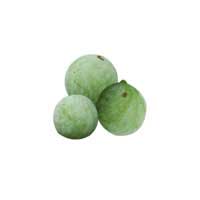 Full List of Fruits
Full List of Fruits  Nageia Fruit
Nageia FruitNageia Fruit
Scientific name - Nageia nagi
Nageia belongs to Podocarpaceae family which generally includes evergreen shrubs and trees. The species grows from 1 to 54 meters in height and it is noted that Nageia is the only species of this family that tend to possess multi-veined leaves. The size of the leaves vary from 5-20 cm long and 2-6 cm broad.
Nageia can be seen in both evergreen and deciduous forest. Mostly the species is seen in hilly areas that range about 200m to 1200 m a.s.l. the tree can grow healthy only in regions that have enough shade: Taxus chinensis, Cephalotaxus fortunei, Keteleeria fortunei, and Fokienia hodginsii are the most common that grows in this type of vegetation. In drier mountain areas Nageia tend to acquire its habitation by following the streams.
Nageia nagi is considered as a valuable timber tree and it is used widely in China and Japan for making furniture. It is also grown as an ornamental tree in gardens, parks and sanctuaries. It is grown popular as a tree for bonsai cultivation. The species is found to be grown rare in Europe, USA and New Zealand.
When planting Nageia fruit, it's important to select a site that receives full sun for at least 6 to 8 hours each day. The soil should be well-drained, with a slightly acidic pH balance. If you're planting in containers, use a potting mix that contains organic matter, such as compost or aged manure.
When you're ready to start planting, dig a hole that's twice as wide and deep as the root ball of the fruit tree. Place the root ball in the hole and backfill it with soil. Firmly tamping down the soil after planting is essential to ensure that the fruit tree is well-anchored in the ground.
Once the tree is planted, water it deeply and frequently to keep it well-hydrated. Mulching around the base of the tree will help to keep the soil moist and control weeds. Fertilizing the tree twice a year, once in the spring and once in the fall, will help to ensure that it receives the nutrients it needs for healthy growth.
Nageia fruit trees should be pruned each year to keep them healthy and encourage maximum yields. Pruning should be done in the late winter or early spring and should include removing any dead, diseased, or damaged branches.
Harvesting Nageia fruit typically takes place from mid-summer to early fall, depending on the climate. The fruit can be eaten fresh off the tree or used to make jams, jellies, and other preserves.
Cultivating Nageia fruit is a great way to enjoy the delicious and nutritious fruit without having to worry about it being too difficult to grow. With the right soil, sunlight, water, and nutrients, Nageia fruit can be a rewarding addition to any garden.
Nageia is propagated through seeds, cuttings, and layering. Seeds should be collected from healthy trees and planted in the spring. The seeds should be sown in a well-drained, sandy soil and lightly covered with soil. The seedlings should be kept moist and in a shaded area until they are established.
Cuttings can also be taken from healthy trees. Cuttings should be taken from the terminal shoots and should be 3-5 cm in length. The cuttings should be treated with a rooting hormone and then planted in a well-drained, sandy soil. The cuttings should be kept moist and in a shaded area until they are established.
Layering is another method of propagating Nageia. This method involves taking a branch from the tree, bending it down to the ground, and burying the end of the branch in soil. The branch should be kept moist and in a shaded area until it develops roots. Once the branch has developed roots, it can be cut from the parent tree and planted in its permanent location.
As Nageia is a slow-growing tree, it can take several years before the seedlings or cuttings will produce fruit. Once the trees are mature enough to produce fruit, the cones will take up to two years to mature. The cones will start to open when they are ripe, revealing the seeds inside. The seeds can then be collected and planted where desired.
Nageia is a long-lived tree and can be a great addition to any garden or landscape. With the right care and propagation methods, it can produce a bounty of fruit for years to come.


















